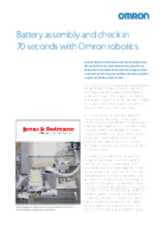Jonas & Redmann automates assembly of small primary lithium batteries for medical devices based on Omron eCobra Pro Scara Robot and camera technologies. Great worldwide demand requires reliable automation. Holistic support accelerates project success.
The European medical technology market is estimated to make up 29% of the world market, as the second largest medical technology market after the US with approximately 43%. In Germany, the industrial health industry has been growing continuously and faster than the German economy since 2009. This includes, for example, the production, distribution and wholesale of medicines and medical technology.
Berlin-based engineering company Jonas & Redmann focuses on medical technology, in addition to other business areas of assembly automation, energy storage and photovoltaics. Jonas & Redmann relies on the technology and expertise of Omron to automate the assembly of primary lithium batteries for a medical device application of a US-based client. The eCobra Pro Scara robot, in combination with powerful camera and visualization technology and a triple gripper, supports accurate layering and precise assembly.
Through automation, the American customer now aims produce the batteries in large volumes, while increasing efficiency and accuracy, enabling the industrial production of the sensitive product. The automation solution from Omron also includes feeding and positioning of the main components (anode and cathode) with four joint robotic units, including machine vision. In addition to the positioning, high-resolution quality inspection with machine vision is carried out after the punching process.
Jonas & Redmann has been relying on the robots, solutions and expertise of Omron for more than 15 years. "The overall concept combining robotics and image processing was crucial in the selection process," explains Frank Neumann, Field Sales Engineer Sensing, Safety and Components at Omron. However, also the relationship and trust between customer and supplier played a central role.
Preventing metal abrasion during battery mounting
Preventing metal abrasion within the machine posed a particular challenge. "The entire production process of the battery cells had to take place without any formation of metal particles," reports Tobias Gensicke. The handling of the specific lithium metal used in the production of the batteries also required special attention in the robot selection process. Robots, grippers and configuration options needed to allow fast and reliable handling of very sensitive materials. Another requirement was the perfect adjustment of robot and gripper technology. During the project, the eCobra Pro was configured to handle extremely small components. In addition, the robot had to utilize an integrated camera to ensure that no relative movement of metals could occur without full encapsulation.
Executing stacking, punching and pressing processes safely and precisely
The stacking and punching of the electrodes are at the heart of the triple gripper application. The robotic arm first picks up the lithium and the anode, which are joined together in the next step. This is followed by the sealing of the anode and the cathode and, in a last step, the juxtaposition of the two battery components (anode and cathode). Four camera units monitor the entire assembly process.
In the final stage of the project, the machine will assemble and check each battery in 70 seconds.
